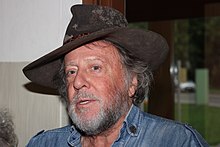Gunter Demnig

Gunter Demnig (born 27 October 1947 in Berlin) is a German artist. He is best known for his Stolperstein ("stumbling block") memorials to the victims of Nazi persecution, including Jews, homosexuals, Romani and the disabled. The project places engraved brass stones in front of a former residence for a Holocaust victim who was deported and murdered by Nazi Germany. The memorial effort began in Germany and has since spread, with more than 100,000 stones placed across 26 countries in Europe.[1][2]
Biography
[edit]Gunter Demnig grew up in Nauen and Berlin and completed high school acquiring his abitur in 1967. Later that year, he began studying creative education at Berlin University of the Arts with Professor Herbert Kaufmann. From 1969 to 1970, he studied industrial design there. In 1971, he transferred to the Kunsthochschule Kassel, resuming his study of creative education and passed the first state examination in 1974.
That same year, he began studying art with Harry Kramer at the University of Kassel. Following that, he spent two years planning, building and managing historical monuments, from 1977 to 1979. From 1980 to 1985, Demnig was an artistic-scientific colleague on the art faculty at the University of Kassel.
In 1985, he opened his own studio in Cologne and worked on numerous local projects. Since 1994, he has also been involved with the IGNIS-Kulturzentrum (IGNIS Cultural Center).
Demnig's best known work is what he calls Stolpersteine. Stolperstein (in the singular) is the German word for "stumbling block". Demnig's Stolpersteine are small, cobblestone-sized brass memorials for the victims of National Socialism. Set into the pavement of sidewalks in front of the buildings where Nazi victims once lived or worked, they call attention both to the individual victim and the scope of the Nazi war crimes. By 2017, about 61,000 Stolpersteine had been laid in 21 countries in Europe,[3] making the project the world's largest memorial.
Works
[edit]
HERE LIVED
Max Kallmann
Born 1899
Escaped to France
Deported 30 June 1944
Murdered in Auschwitz
- 1980: Odor marks, Cassel-Paris
- 1981: Blood spot, Kassel-London
- 1988: Travel to West Berlin
- 1993: Conceives Stolpersteine project
- 1997: First two Stolpersteine installed at the invitation of Austrian Holocaust Memorial Service founder Andreas Maislinger for the brothers Matthias and Johann Nobis, with legal permit from St. Georgen (near Salzburg)[5]
- 2000: Project Stolpersteine continues, acquiring permits to install the memorials
Shows
[edit]- 1982: Alte Oper, Frankfurt am Main
- 1986: Kunsthalle Baden-Baden, Museum of the City of Cologne
- 1991: Kunstlerhaus Bethanien, Berlin
- 1995: Academy of Arts, Berlin
Stolpersteine in different countries
[edit]- Austria: Stolpersteine in the district of Braunau am Inn
- Belgium: Stolpersteine in Charleroi
- Czech Republic: Prague: Josefov, Malá Strana, Vršovice and Modřany — Královéhradecký kraj, Ústecký kraj
- Germany: Lake Constance district, Weingarten
- Netherlands
- Ireland: St Catherine's school, Donore Avenue, Dublin [1]
References
[edit]- ^ "10 Fakten über Stolpersteine". Goethe-Institut. Retrieved 10 July 2022.
- ^ "In Nürnberg liegt jetzt Europas 100.000 Stolperstein". www.nn.de (in German). Retrieved 2023-05-29.
- ^ Iken, Katja (19 July 2017). "Gunter Demnigs Stolpersteine: Erinnerung an Opfer des Holocaust". Der Spiegel.
- ^ "Orte & Biografien der Stolpersteine in Berlin: Max Kallmann" (in German). Stolpersteine in Berlin.
- ^ "Stolpersteine zur mahnenden Erinnerung" Archived 2009-07-07 at the Wayback Machine Press release, Austrian news archive. (July 17, 1997) (in German)
External links
[edit]- Stolpersteine website
- Demning résumé at IGNIS Archived 2021-12-04 at the Wayback Machine
